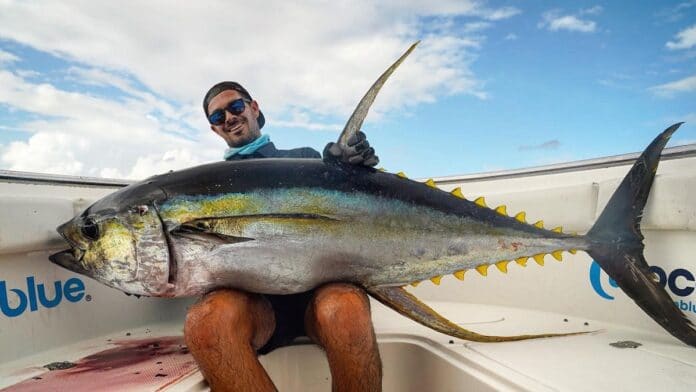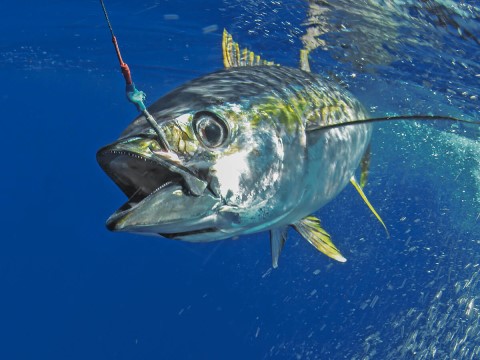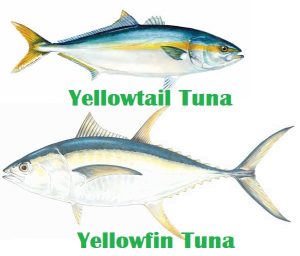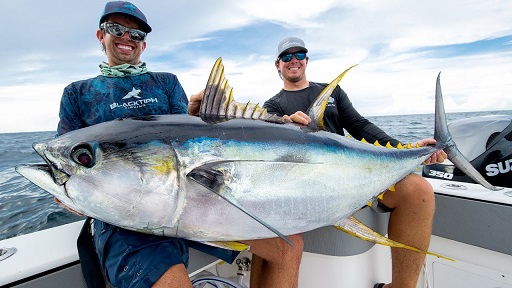
Yellowfin Tuna Ahi Fishing Guide
Discover everything you need to know about Yellowfin Tuna or Ahi Tuna.
Yellowfin Tuna is often called Ahi in Hawaii. It is one of the most popular and versatile fish you can find in kitchens worldwide. You may be searing it, grilling it, or eating it raw in sushi, it’s known for its mild flavor and firm texture. Did you know that Yellowfin Tuna can reach speeds up to 50 miles per hour? That’s faster than most fish, and why they are so exciting to catch! Let’s dive into everything you need to know about Yellowfin or Ahi Tuna.
What Is Yellowfin Tuna Ahi?
Yellowfin Tuna (also known as Thunnus albacares or “Ahi” in Hawaiia) is a species of tuna that is deep blue on top with a shallow yellow line in the middle of their body going to the tail. Their fins are also yellowish in color. Yellowfin is one of the larger tuna species and very tasty.
Yellowfin tuna have the potential of reaching up to a weight of 400lbs or 180kg. They are mainly found in the warmer offshore waters such as Gulf of Meixco, Hawaii, Caribbean, Eastern and Western Pacific.
Yellowfin tuna group together in enormous schools and can be seen feeding as they break the surface chasing after bait. Like other Tuna species they eat a large number of different bait fish like sardines and mackerel, squid, and even small pelagic crabs.
Yellowfin tuna are strong fighters. Like all tuna they pull hard for their size, and as mentioned above, they can get quite large. They almost never jump when hooked, instead swim in large circles making it a long process to get them in the boat. They are a great gamefish and a pleasure to catch. As a bonus, they are also great to eat.
- Overview of Yellowfin Tuna (size, where it’s found, other names like Ahi).
- Difference between .
- Cultural significance, especially in Hawaii and Japan.
Yellowfin vs Yellowtail Tuna
Yellowfin tuna and Yellowtail tuna are both species of fish that belong to the same family, Scombridae, but they are different species. Yellowfin tuna (Thunnus albacares or Ahi) is a species of tuna that is found in the open waters of the tropical and subtropical oceans worldwide, while yellowtail tuna is a species of tuna that is found primarily in the waters off the coast of Japan and Australia.
The two species can be distinguished by the size, color, and location of the yellow fins.
Yellowfin tuna is a large fish that can grow up to 6.5 feet in length and weigh up to 440 pounds. It has a metallic blue-black back and upper sides with a silver belly and bright longer yellow fins. Yellowtail tuna, on the other hand, is a medium-sized fish that can grow up to 6 feet in length and weigh up to 110 pounds. It has a dark blue back and upper sides with a silver belly and smaller yellow fins. Yellowfin tuna has yellow fins that are located at the top of its body and are longer, while yellowtail tuna has yellow fins that are located at the bottom of its body and are smaller.
Yellowfin tuna is considered to have a stronger flavor and firmer texture than yellowtail tuna. Yellowfin tuna is often used for sashimi and sushi, while yellowtail tuna is often grilled or served as sashimi. Yellowtail tuna is considered to be a good choice for grilling or cooking because of its milder flavor and softer texture. It is also considered to be a good choice for raw fish dishes because of its softer texture and milder flavor.
Yellowfin Ahi vs Bluefin Tuna
Bluefin tuna grows larger than yellowfin and ofcourse does not have the distinctive yellow fins. Some Bluefin tuna reach over 1,000 pounds, while yellowfin usually max out around 400 pounds.
Yellowfin tuna (Ahi) is known for its mild flavor and firm texture, making it perfect for grilling and searing, while bluefin tuna has a richer, more buttery taste, ideal for high-end sushi and sashimi.When it comes to color, yellowfin tuna has a bright red flesh that lightens when cooked, while bluefin tuna’s flesh is a deeper red and prized for its melt in your mouth texture when served raw.
While both species are prized in culinary circles, yellowfin is often favored for its sustainability, as bluefin tuna populations have been overfished and are more critically endangered.
How to Catch Ahi Tuna
Yellowfin Tuna can be caught via trolling, chunking, jigging, and live baiting. There are many techniques and it’s good to be familiar with them, fish can be tricky to catch some days. These fish are often found in deep, open waters, so anglers typically use heavy tackle and large lures or live bait to target them.
The easiest way to catch yellowfin tuna is when they are breaking the surface feeding. They usually in a feeding frenzy and throwing your lure amongst the bait fish is sure to produce results. Spot the tuna schools by looking into the sky and seeing where birds are flocking, they are usually above the schools picking off baitfish. When the water’s surface is breaking with activity, tuna are feeding. Get your boat as close to the school and throw your lures into the feed zone.
Trolling is a tried and traditional technique for tuna. Visit this post for detailed Tuna Trolling Info
Another techniques is to lure the yellowfin to you. Whether you are fishing with lures or bait, chum is effective on tuna of all sorts, and Yellowfin are no exception. You can either chum with live bait or chunks of cut bait. That helps keep the fish around the boat.
Best Yellowfin Tuna Fishing Locations
Yellowfin tuna are found in warm offshore waters around the world. Some of the best locations for targeting them include.
Gulf of Mexico particularly around the oil rigs and other structures where baitfish congregate. Hawaii as the waters around the islands are rich in marine life, providing plenty of food for yellowfin tuna to thrive.Caribbean Sea particularly around the islands and along the continental shelf. Eastern Pacific waters off the coast of Central and South America are also known for their yellowfin tuna populations year round. Western Pacific particularly around Japan and the Philippines, is another hotspot for yellowfin tuna. The area is known for producing some of the largest yellowfin tuna in the world.
Yellowfin tuna are typically caught year round, but the best time to fish for them varies by location. In the Gulf of Mexico and the Caribbean, the peak season is from late spring to early fall. In Hawaii Ahi as the local call them can be caught year round, with the best fishing from May to September. The Eastern and Western Pacific also offer year round fishing opportunities, with peak seasons varying by region.
Yellowfin Ahi Fishing Equipment
Fishing for yellowfin tuna or ahi requires the right tackle and gear to handle these powerful and large fish.
- Rods and Reels Heavy-duty rods and reels are essential for yellowfin tuna fishing. A rod with a high line rating (50-100 lbs) and a strong reel with a high line capacity (500+ yards) are recommended.
- Line Braided line is commonly used for yellowfin tuna fishing because of its strength and low stretch. A line with a test strength of 50 to 100 pounds is recommended. Some anglers also use fluorocarbon leaders to increase their chances of a bite as these are less visible in the water.
- Hooks and Lures Circle hooks are often used for yellowfin tuna fishing because they are less likely to be swallowed by the fish, resulting in a higher chance of a successful catch and release. Live bait such as sardines or mackerel is commonly used. Artificial lures such as jigs and trolling lures can also be effective.
- Gaff A strong gaff is essential for landing large yellowfin tuna. A gaff with a long handle and a sharp hook will help you secure the fish and bring it on board.
How to Cook Yellowfin Tuna Ahi
See below for some recommendations on how to cook Yellowfin or Ahi Tuna.
Seared Ahi Tuna
To achieve the perfect crust on seared ahi tuna, pat the tuna steaks dry and season them generously with salt, pepper, and sesame seeds before searing. Preheat your pan to high heat with a bit of oil, and sear the tuna for about 1-2 minutes on each side…just enough to form a golden brown crust while keeping the center rare. Make sure your tuna is sushi grade if you plan to serve it rare or medium rare, and let it rest for a minute before slicing for that perfect presentation.
Grilled Yellowfin Ahi Tuna with a Citrus Marinade
For a flavorful grilled yellowfin tuna, marinate the fish in a citrus blend of lemon, lime, garlic, and olive oil for at least 30 minutes to let the flavors soak in. Grill the tuna over medium to high heat for 2-3 minutes per side, ensuring you don’t overcook it. The goal is a tender, flaky inside with a slightly charred exterior. Serve the grilled yellowfin tuna with a fresh squeeze of citrus on top to really bring out the bright, zesty flavors of the marinade.
Ahi Poke Bowls
Start by sourcing the freshest sushi grade ahi tuna you can find, and dice it into small, even cubes for the perfect poke texture. Mix the tuna with soy sauce, sesame oil, green onions, and a bit of sriracha or chili flakes for a spicy kick, letting it marinate for at least 15 minutes. Assemble your poke bowl by layering rice, avocado, cucumber, and seaweed salad, then top it off with your marinated ahi and a sprinkle of sesame seeds.
Yellowfin Ahi Sushi and Sashimi Preparations
For sushi, slice your ahi tuna into thin, even pieces to lay atop seasoned sushi rice, making sure the fish is fresh and chilled before serving.
When preparing sashimi, use a sharp knife to cut the tuna into thicker, clean slices, and serve it simply with soy sauce, wasabi, and pickled ginger. Ensure your tuna is sushi grade and free from any veins or imperfections, as sushi and sashimi rely on the highest quality, freshest fish for the best flavor.
Visit our post on How to Clean Tuna
Yellowfin Tuna Ahi Nutritional Benefits
Yellowfin tuna is packed with high quality protein, providing around 24 grams per 3 ounce serving. Protein is essential for muscle growth and repair, making ahi tuna an excellent choice for athletes or anyone looking to build and maintain lean muscle mass. With only about 110 calories per 3-ounce serving, yellowfin tuna is a fantastic low-calorie option for those on a lean diet. Its high protein content keeps you full, while the low calorie count helps support weight management and fat loss goals.
Yellowfin tuna is a powerhouse of essential vitamins and minerals, including vitamin B12, which supports energy production and nerve health, and vitamin D, which is important for bone health and immune function. It also contains selenium and potassium, key for metabolic and heart health.
Yellowfin tuna is rich in omega-3 fatty acids, which are known to support heart health by reducing inflammation, lowering triglyceride levels, and promoting overall cardiovascular function. Regular consumption of omega-3s can also help reduce the risk of heart disease.
Yellowfin Tuna Ahi FAQs
What is the best bait for yellowfin tuna?
The best bait for yellowfin tuna depends on the fishing method. Live bait such as sardines, mackerel, and squid are highly effective. For trolling, lures like cedar plugs and skirted lures work well. Matching the hatch, using bait that mimics the local prey species is key to success.
What is the best time of year to catch yellowfin tuna?
Yellowfin tuna can be caught year-round, but the best time varies by location. In the Gulf of Mexico, the peak season is from late spring to early fall. In Hawaii, the best fishing is from May to September. Check local fishing reports for the most accurate timing in your area.
How do I distinguish between yellowfin and yellowtail tuna?
Yellowfin tuna have long, bright yellow dorsal and anal fins, a metallic blue black back, and a silver belly. They are larger and more robust. Yellowtail tuna have shorter yellow fins located closer to the belly and a prominent yellow stripe running along their sides. They are generally smaller and have a more slender body.
Biggest yellowfin tuna ever caught?
The largest yellowfin tuna on record weighed 427 pounds and was caught off the coast of Mexico in 2012. This record setting fish was caught by angler Guy Yocom using a live bait rig.
Is yellowfin tuna good to eat?
Yes, yellowfin tuna is highly prized for its taste and texture. It is commonly used in sushi, sashimi, poke, and grilled dishes. The meat is firm, flavorful, and rich in healthy omega-3 fatty acids.
Where are the best places to fish for yellowfin tuna?
Top locations for yellowfin tuna fishing include the Gulf of Mexico, Hawaii, the Caribbean, the Eastern Pacific, and the Western Pacific. These regions offer warm, offshore waters rich in marine life, providing ideal conditions for yellowfin tuna.
Keywords
- Ahi tuna recipes
- Fresh yellowfin tuna
- Ahi poke bowl
- Tuna nutrition facts
- How to cook ahi tuna
- Searing ahi tuna
- Grilling yellowfin tuna
- Yellowfin tuna health benefits
- Sustainable fishing practices
- Omega-3 in yellowfin tuna
- Tuna mercury levels
- Sushi-grade ahi tuna
- Yellowfin tuna vs bluefin
- Where to buy ahi tuna
- Tuna fishing regulations
- Marine Stewardship Council tuna
- Ahi tuna marinade
- Hawaiian ahi tuna dishes
- Wild-caught yellowfin tuna
- Tuna preservation methods
- Tuna species comparison
- Tuna sourcing tips
- Fresh vs frozen tuna
- Tuna recipe ideas
- Tuna sustainability certifications


 Shimano Trinidad Reels
Shimano Trinidad Reels Fishing Reels
Fishing Reels Braided Fishing Line
Braided Fishing Line
 Penn Tuna Fishing Rod & Reel Combo
Penn Tuna Fishing Rod & Reel Combo Cedar Plugs Tuna Fishing Lures
Cedar Plugs Tuna Fishing Lures View Best Tuna Fishing Lures
View Best Tuna Fishing Lures Stainless Steel Fishing Leaders
Stainless Steel Fishing Leaders Fishing Rod Holder
Fishing Rod Holder Lures Bait Rig Or Hooks
Lures Bait Rig Or Hooks

 Blue Fly Fish Saltwater Trolling Fishing Lures
Blue Fly Fish Saltwater Trolling Fishing Lures Saltwater Trolling Lure for Tuna
Saltwater Trolling Lure for Tuna